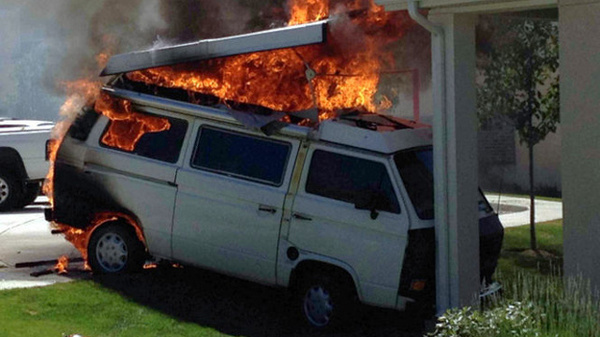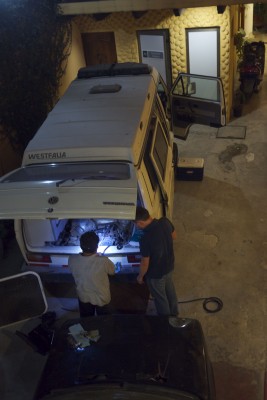One of the Vanagon’s design, um, “characteristics” is that a few of the hoses that deliver gasoline to the engine run just over the exhaust. This is necessary given that the engine is in the rear, but without proper maintenance it can be very dangerous. “Change the fuel lines” is the first piece of advice that new owners get on the VW forums. Stories of fuel-line related fires seem common.
I of course knew this, and in June 2011 had Art change all the fuel lines in the engine compartment. Even though I had reason to think the lines were just six years old at most.


The hotel where we stayed in Oaxaca had a narrow entrance, and there was no way to turn the van around before leaving. So I asked Stephanie to stay outside to help me maneuver. After a few seconds, I heard her yell: “there’s liquid pouring out of the car!”. I killed the engine immediately, ran outside, and found gasoline. Dripping on the exhaust. A plastic fitting where the hose leaves the engine had failed.
We canceled our departure, got another night at the hotel, and left the van parked diagonally as it was. The hotel owner had a mechanic who could make a house call that evening, and I set off to get some proper new hose to install.
We fixed it in a way that makes it impossible for it to leak from the same place, but still, I’ve been checking for leaks every morning since then. And I’ve leaned more about the Vanagon fuel lines that I thought I’d ever would. Looks like we dodged a bullet!
[google-map-v3 width=”0″ height=”0″ zoom=”12″ maptype=”roadmap” mapalign=”center” directionhint=”false” language=”default” poweredby=”false” maptypecontrol=”true” pancontrol=”true” zoomcontrol=”true” scalecontrol=”true” streetviewcontrol=”true” scrollwheelcontrol=”false” draggable=”true” tiltfourtyfive=”false” addmarkermashupbubble=”false” addmarkermashupbubble=”false” addmarkerlist=”17.056123, -96.726533{}van.png” bubbleautopan=”true” showbike=”false” showtraffic=”false” showpanoramio=”false”]

